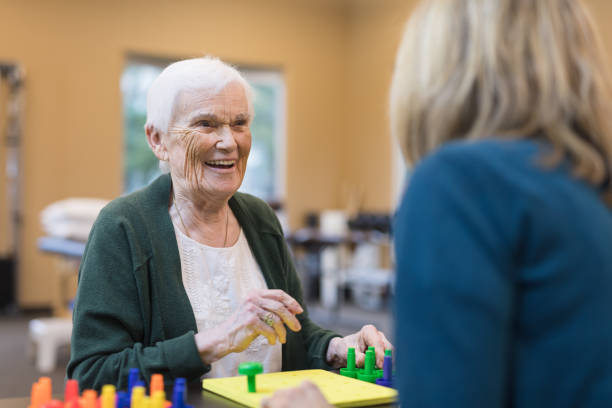As we age, it’s natural for certain muscle groups to lose strength, including those responsible for speech, swallowing, and breathing coordination. For seniors, especially those with underlying conditions such as Parkinson’s disease, stroke, or general neuromuscular degeneration, muscle weakness can significantly impair the ability to communicate clearly and eat safely. While many people associate speech therapy with children or post-surgical rehabilitation, it plays an equally vital role in geriatric care.
Speech therapy for seniors goes far beyond correcting articulation or enhancing vocabulary. It helps preserve independence, dignity, and quality of life. For older adults struggling with slurred speech, low vocal volume, or trouble swallowing, speech-language pathologists (SLPs) can create personalized treatment plans to address both the physical and cognitive aspects of communication. As the population continues to age, speech therapy is becoming a cornerstone of holistic elder care.
Contents
Recognizing the Signs: When Is Therapy Needed?
Muscle weakness that affects speech can present subtly. A senior may suddenly begin trailing off mid-sentence or need to repeat themselves more often. They might cough during meals, avoid phone conversations, or feel winded after speaking. These symptoms can be signs of dysarthria—a motor speech disorder caused by weakened or poorly coordinated muscles involved in speaking. In more severe cases, they might develop dysphagia, or difficulty swallowing, which can lead to serious complications like malnutrition or aspiration pneumonia.
Family members and caregivers should be vigilant in identifying these changes. While it’s tempting to attribute them to “just getting older,” intervention can make a profound difference. A timely referral to a speech therapist ensures that the senior receives the support they need before more severe issues develop.
The Role of Speech-Language Pathologists in Geriatric Care
Speech-language pathologists specialize in evaluating and treating communication and swallowing disorders. For seniors, this often means working to restore speech clarity, rebuild vocal strength, and develop strategies for safer swallowing. Therapy typically starts with an assessment, where the SLP evaluates the individual’s breath support, articulation, muscle tone, and ability to form sounds and words.
Depending on the diagnosis, therapy sessions may include a variety of exercises. These can range from gentle resistance training to strengthen oral muscles, to breath coordination drills, to practicing specific sound production. Cognitive-linguistic therapy may also be incorporated if memory, attention, or problem-solving are contributing to communication difficulties.
Importantly, therapy doesn’t take a one-size-fits-all approach. Each plan is tailored to the individual’s goals, medical history, and current ability level. Whether it’s being able to call a grandchild, join a conversation at dinner, or swallow without fear, SLPs build therapy around the daily functions that matter most to the senior.
Swallowing Therapy: Safety Meets Dignity

Many seniors with muscle weakness experience difficulty swallowing, which can be both physically dangerous and emotionally distressing. Swallowing therapy—formally called dysphagia management—is a major focus of geriatric speech therapy. The goal is to make eating safe and enjoyable again.
SLPs use diagnostic tools such as bedside swallow evaluations or videofluoroscopic studies to assess how well the muscles in the mouth, throat, and esophagus are working together. From there, therapy may involve teaching compensatory strategies (like specific head postures during swallowing), dietary modifications (such as thickened liquids), or strengthening exercises to improve the timing and force of each swallow.
These interventions do more than prevent health complications. They help seniors retain their dignity and autonomy at mealtime, which can have profound psychological benefits.
Technology and Tools That Enhance Progress
Modern speech therapy for seniors increasingly incorporates technology to enhance results and engagement. Tools like vocal intensity monitors, biofeedback software, and mobile therapy apps allow seniors to practice exercises at home and track their progress. Virtual speech therapy (telepractice) has also gained traction, making therapy accessible for those with mobility issues or in rural areas.
Additionally, simple devices such as amplifiers or communication boards can provide immediate support while longer-term therapy goals are being pursued. Caregivers and family members can be trained to use these tools, making them a vital part of the therapeutic process.
The Emotional and Social Benefits of Therapy
Beyond the physical improvements, speech therapy can significantly boost a senior’s emotional well-being. Struggling to speak or eat can lead to social withdrawal, anxiety, and depression. Therapy helps rebuild confidence, allowing seniors to reengage with their communities, families, and routines.
By restoring the ability to express needs, share stories, and connect with others, speech therapy supports not just communication, but connection—a critical element of emotional health in aging.
A Restorative Path Forward
Speech therapy for seniors with muscle weakness isn’t just about recovering what’s been lost—it’s about building a better quality of life with the tools available. Through personalized care plans, innovative techniques, and a compassionate approach, speech-language pathologists are empowering older adults to speak, eat, and live with greater ease.
As awareness of this field grows, more families are recognizing the importance of early intervention and ongoing support. For seniors facing muscle-related communication or swallowing issues, speech therapy offers a path forward that honors both their health and humanity.
